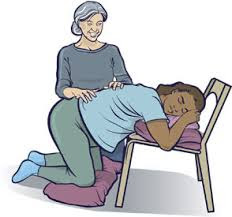1 stage of labour
It starts from onset of true labour pain & ends with two dilatation of cervix. Also called cervical stage..
Duration-12 hours in primigravidae & 6 hrs in multiparae.
 |
| 1 stage of labour |
Events:-
a> dilatation & effacement of cervixb> full formation of lower uterine segment
aim=preparation of birth canal so as to facilitate expulsion of fetus in 2 stage
A> dilatation of cervix=
-in prelabour stage there may be little dilatation of cervix specially in multiparae
factors which favours smooth dilatation=softening of cervix,accumulation of fluid in between collagen fibres,increased vascularity,breaking down of collagen fibres by collagenase & elastase, change in various glycosaminoglycans,
Factors Responsible:-
1) uterine contraction & retraction2) bag of membranes=with the onset of labours membranes attached to the lower uterine segment are detached & with the rise in intrauterine pressure during contraction there is herniation of membranes throgh cervical canal.
3) fetal axis pressure=there is tendency of straightning out of fetal vertebral column due to contraction of circular muscle of body of uterus.This allows fundal contraction to transmit through podalic pole into the fetal axis which helps opening up of cervical canal
4) Vis-a-tergo=final stage of dilatation.It is due to downward thrust of presenting part of fetus & upward pull of cervix over lower segment
B) effacement =process by which muscular fibres of the cervix are pulled upward & merges with the fibres of the lower uterine segment.
C) lower uterine segment formation= it is the part to which peritonium is loosely attached .When fully formed it measures about 7.5 to 10 cm from the internal os , cylindrical in shape.Factors responsible for thining of wall =relaxation of muscle fibres causing elongation , contraction & retraction of the muscle fibres of upper uterine segment thereby drawing up of lower segment & cervix.,fetus pushed down causes further stretching of the wall called receptive relaxation.
Managment=
A)Principals=
1)non interferance with watchfull expectancy so as to prepare the patient for natural birth
2)to monitor carefully the progress of labour , maternal conditions ,fetal behaviour so as to detect any intrarapartum complication early
B)preliminaries= basic evaluation of the current clinical condition , inquiry about onset of labour pains & leakage of liquor, general & obsetrical examination including vaginal examination , records of antenatal visits,investigations report,any specific treatment given
C)actual managment=
1)General-antiseptic dressing
-encouragment & assurance
-constant supervision
2)bowel-enema with soap & water or glycerine suppository.
-given when rectum feels loaded on vaginal examination
3)rest & ambulation=if membranes are intact patient is allowed to walk about.This prevents venacaval compression & encourages descent of head.
Ambulation can reduce the duration of labour ,need of analgesia , improves maternal comfort
4)diet= there is delayed emptying of stomach in labour. So food is withheld during labour
5)bladder care =patient is encouraged to pass urine by herself as full bladder inhibits uterine contractions & may lead to infection.If women can not go to toilet she is given a bed pan.
6)relief of pain= pethidine 50-100 mg im when the pains are well established in the active phase of labour .If necessary repeat after 4 hours.
Metoclopramide 10 mg im is given to combat vomiting due to pethidine.
Drugs should not be given if delivery is anticipated within 2 hours
7)assessment of progress of labour & partograph recording=
a)abdominal finding=uterine contractions -no of contractions in 10 min & duration of each contraction in seconds are recorded in the pastograph
b)pelvic grip=gradual disappearance of the poles of the head
c)shifting of the maximal impulse of the fetal heart beat downwards & medially
8)Fetal heart rate=done to note the fetal wellbeing
Rate ,rhythm & intensity noted every half hour in the first stage .Observations should be made immediately following uterine contraction .Count should be made for 60 sec.
9)continuous electronic fetal monitoring =recording of fetal heart action by fetal ECG& uterine contractions by tocography
10)vaginal examination -
-dilatation of cervix in cm in relation to hours of labour
-to note position of the head & degree of flexino
-to note station of head in relation to ischial spine
-color of liquor
-degree of moulding of head
-caput formation
11)to watch maternal conditions-
-to record 2 hourly pulse ,BP,temperature
-observe the tongue periodically for hydration
-urine output ,sugar ,acetone
-iV fluids &drugs
thanks for reading.

EmoticonEmoticon